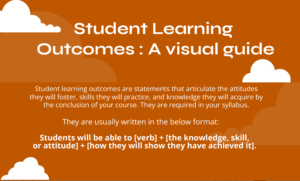Developing Learning Outcomes for Your Course
Clearly-articulated learning outcomes build the foundation for effective courses and guide the development of course lectures, assignments and assessments. When learning outcomes are included in syllabi, as required by HB 2504, it communicates to students what faculty want them to be able to demonstrate and do by the end of a course, as well as what they will gain from it.
What is the difference between learning outcomes and learning objectives?
The difference between learning outcomes and objectives has to do with who performs the activities. Learning objectives describe what an instructor aims to do, as a result, they are instructor-centered statements. Whereas, learning outcomes describe what a student will be able to do after completing a learning experience. These statements are learner-centered and help students to know what to expect from a course.
How do I write learning outcomes?
Student learning outcomes are statements that articulate the attitudes they will foster, skills they will practice and knowledge they will acquire by the conclusion of your course.
Most course-level learning outcomes are expressed in this format:
Students will be able to [verb] + [knowledge, skill, or attitude] + [how they will show they have achieved it].
Faculty are encouraged to design courses by integrating a balanced blend of learning outcomes (attitude, skill and knowledge) that aligns with the focus and requirements of their course.
Student Learning Outcomes Visual Guide
Click on the image below for tips and examples about developing good learning outcomes.
Need more help?
Find tips and examples in the Student Learning Outcomes Visual Guide.
The Course Clarity Project team also offers workshops and presentations on writing effective learning outcomes. If interested, please contact us through the Center for Teaching and Learning.
